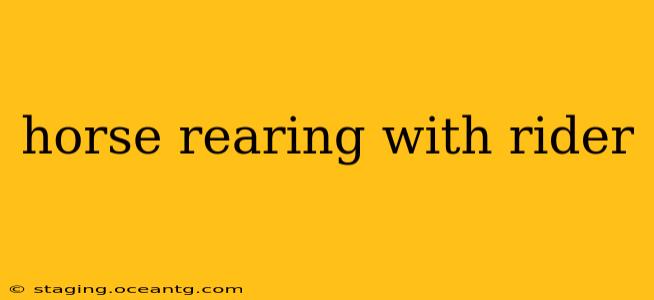Horse rearing, where a horse rises up on its hind legs, is a dramatic and potentially dangerous behavior. While sometimes a playful display, it frequently indicates a problem that requires immediate attention. This comprehensive guide explores the causes of rearing, techniques for handling a rearing horse, and crucially, safety measures for both horse and rider.
What Causes a Horse to Rear?
Several factors can trigger a horse to rear, ranging from simple misunderstandings to serious underlying issues. Understanding these causes is the first step towards preventing this dangerous behavior.
Pain or Discomfort:
A horse might rear to escape pain stemming from back problems, saddle sores, dental issues, or other physical ailments. The discomfort can lead to an exaggerated reaction to even minor stimuli.
Fear or Anxiety:
Horses are prey animals inherently sensitive to their surroundings. A sudden noise, unfamiliar object, or perceived threat can cause a fearful reaction, manifesting as rearing. This is often coupled with other signs of anxiety, such as pinned ears or a tense body.
Misunderstanding of Rider's Cues:
Poor riding techniques, inconsistent signals, or harsh handling can confuse a horse, leading to rearing as a means of expressing frustration or avoidance. The horse may be trying to escape an uncomfortable or confusing situation.
Learned Behavior:
Unfortunately, rearing can be a learned behavior. If a horse discovers that rearing gets it out of a situation it dislikes (e.g., avoiding work), it's more likely to repeat the behavior.
Excitement or Playfulness:
While less common, rearing can occasionally be a form of play, particularly in younger horses. However, even playful rearing needs careful management to prevent it from becoming a dangerous habit.
How to Handle a Rearing Horse (Rider Perspective)
Managing a rearing horse requires immediate and decisive action while prioritizing safety. Never allow yourself to be trapped beneath a rearing horse.
Preventing a Rear:
Proactive measures are vital. Maintaining clear communication, using calm and consistent cues, and ensuring the horse's comfort (proper tack fitting, regular veterinary checkups) drastically reduce the likelihood of rearing.
Responding to a Rear:
If a rear is imminent or has begun:
- Release all rein contact immediately. Holding onto the reins can exacerbate the situation, potentially causing the horse to fall backward with you under it.
- Lean forward slightly. This shifts your center of gravity and helps maintain balance.
- Maintain a firm seat and grip. Do not brace against the horse; allow it to move, maintaining an open connection with its back.
- Give the horse the opportunity to take a step forward. Once it starts to regain balance, provide gentle guidance.
- Avoid pulling back on the reins. This only reinforces the behavior.
Seeking Professional Help:
If rearing persists, consult a qualified equine professional, such as a certified riding instructor or equine behaviorist. They can diagnose the root cause of the behavior and help develop a tailored training plan.
Safety Precautions for Horse and Rider
Safety should always be paramount when handling a horse prone to rearing.
Protective Gear:
Always wear a properly fitted riding helmet and appropriate safety equipment, including body protectors.
Suitable Riding Environment:
Choose a safe riding area free from obstacles that could cause a horse to startle or lose its balance. Avoid riding in areas with uneven terrain or unpredictable elements.
Supervision:
If a horse is known to rear, always have someone present to assist in case of an incident. This could be a riding instructor or experienced handler.
Regular Veterinary Checkups:
Ensure regular veterinary checkups to rule out any underlying physical issues that might contribute to rearing behavior.
What should I do if my horse rears while I'm riding?
As detailed above, immediate release of the reins, leaning forward, and maintaining a firm seat are crucial. The key is to avoid reinforcing the behavior by pulling back or becoming tense. After regaining control, dismount and reassess the situation.
How can I prevent my horse from rearing?
Prevention involves consistent training, clear communication, and addressing any underlying issues. Regular veterinary checks, appropriate tack, and calm, confident handling are key. Professional help from an experienced trainer can significantly improve outcomes.
Is rearing a dangerous behavior?
Yes, rearing is extremely dangerous for both horse and rider. It can result in falls, serious injuries, and even death. It's crucial to address rearing promptly and effectively.
This guide offers a starting point for understanding and managing horse rearing. Always prioritize safety and seek professional guidance if you're struggling to address this potentially dangerous behavior. Remember, patience and consistency are key to successful training and a strong, trusting relationship between horse and rider.
